Go to Birding Tour Guatemala | Neotropical bird tours | All our birding tours
06-16 MARCH 2022
By Eduardo Ormaeche
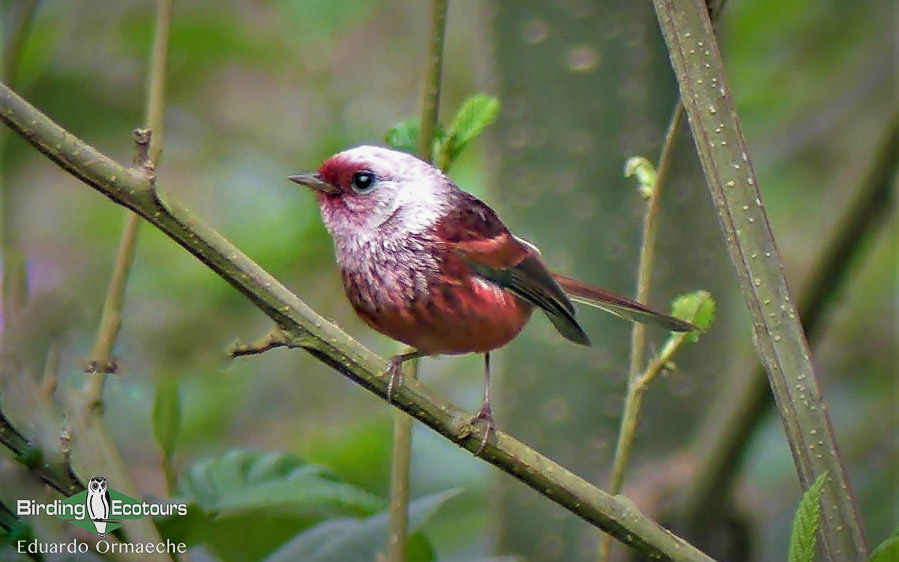
Overview
Guatemala is quite simply an amazing place for travel and birding. Unfortunately, it is often overlooked by birders as it is unfairly overshadowed by other popular Central American birding destinations, however the truth is that Guatemala stands out as a unique destination, which offers great experiences for birders and travelers alike. With a country list of 734 bird species, Guatemala can provide some classic Central American specials such as Resplendent Quetzal, Keel-billed Toucan, Turquoise-browed Motmot, Tody Motmot, Northern Potoo, as well as some range-restricted species, shared with adjacent Chiapas in Mexico, such as Pink-headed Warbler, Horned Guan, Belted Flycatcher, and Azure-rumped Tanager. Western Guatemala offers specials such as Russet-crowned Motmot and Goldman’s Warbler, while the tropical rainforest of Petén provides some of the Yucatan Peninsula specials such as Ocellated Turkey, Yucatan Woodpecker, Yucatan Jay, Yucatan Flycatcher, and Yucatan Nightjar.
Additionally, Guatemala hosts the impressive Tikal National Park with some of the best-preserved Mayan temples in the region. It is a land of active volcanoes, with some of the best coffee and cuisine, and is the home of Mayan heritage. Furthermore, together with Guyana, it is the best place to see the rare Orange-breasted Falcon. The country also possesses interesting Spanish colonial cities such La Antigua, which along with the Tikal Ruins are considered World Heritage Sites.
The following ten-day trip was customized for the participants to enjoy as much birding as possible while also enjoying other cultural and outdoor activities, as the group had multiple interests which we pursued on this holiday. We did our best to satisfy the group and the following tour report provides you with an idea of what Guatemala can offer the birder and general nature traveler. We recorded 242 bird species at a fairly relaxed pace which included a great number of other exciting wildlife.
Detailed Report
We started our Guatemala adventure with a private pre-trip day to hike the Acatenango Volcano. This is one of the volcanoes standing above Guatemala City, which joins Volcan de Fuego (Volcano of Fire), creating a volcano complex known as the Horqueta. Acatenango peak has an elevation of 13,045 feet (3,976 meters) and requires a hike of 4,593 feet (1,400 meters). Today it is a demanding but popular outdoor activity for hikers, and for those who desire to get close-up views and pictures of the magnificent scenery from the top of the volcano. The views from the Volcano of Fire are really impressive and certainly did not disappoint today. This activity was requested as a pre-trip to our birding tour and was one of the highlights for participants and one of the reasons they wanted to visit Guatemala, apart from birds and nature. We helped organize this tour, but I personally did not join, with the group led by our hiking and cultural local guide Leonel, who had a great time with the participants. They even managed to get some birds on the way up such as Yellow-eyed Junco, Grey Silky-flycatcher, and the most-wanted Pink-headed Warbler. The participants enjoyed the day very much and they even had the chance to experience a few eruptions of the Volcano of Fire and mild tremors that added some adrenaline to the incredible experience.
While participants were on their way up the volcano, I took the chance to visit Finca El Pilar which is one of the most popular birding sites in La Antigua and a mandatory hotspot on our tours. I was lucky enough to get the whole finca to myself, as there were no other visitors around. I was dropped off near the top and took the trail down to the parking area. Some of the first birds heard were Brown-backed Solitaire and Blue-throated Motmot but I was distracted by the calls of the secretive Singing Quail, and after some searching, I managed to get brief but good views of a family covey. After this amazing start, I got great views of Blue-throated Motmot, Collared Trogon, Bushy-crested Jay, Velasquez’s Woodpecker and Rufous-browed Wren. Along the main trail, a pair of White-eared Ground Sparrows delighted me with great views of this normally elusive species. The first flock of North American migratory birds soon came into view including species such as Tennessee, Wilson’s, and Black-throated Green Warblers, Philadelphia Vireo and Hepatic Tanager which was a nice surprise. Chestnut-sided Shrike-Vireo and Emerald Toucanet were heard calling but unfortunately, they remained hidden. By the time I arrived at the hummingbird feeders, the activity was a bit low, but I got great views of Rufous Sabrewing, White-eared, Rivoli’s, Berylline, and Azure-crowned Hummingbirds and Green-throated Mountaingem. I left Finca El Pilar after having great views of Black-capped and Northern Rough-winged Swallows, with a fantastic view of the beautiful Water Volcano in the background. I returned to the hotel excited to meet my group and start our birding adventure the next day.
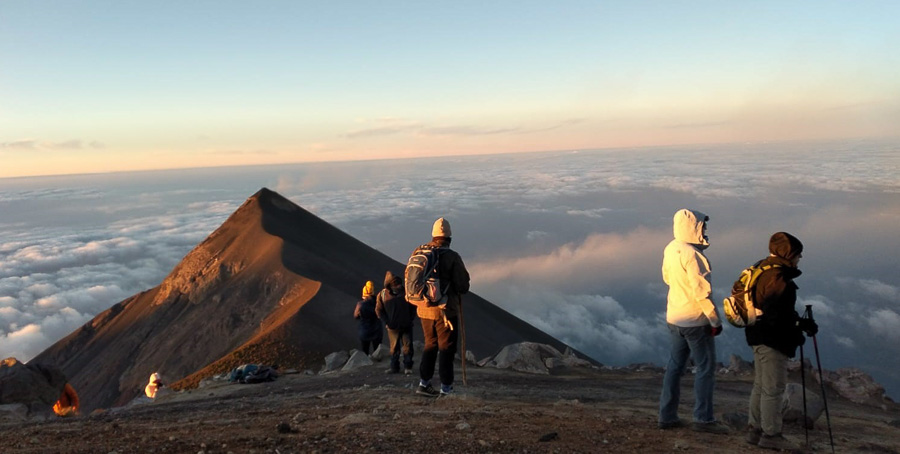 The roof of Guatemala from the top of the Acatenango Volcano (photo Leonel Medina).
The roof of Guatemala from the top of the Acatenango Volcano (photo Leonel Medina).
After the participants returned back to La Antigua from their hike, they decided to rest for the afternoon after a long day’s hiking up the volcano. They were full of enthusiasm for the birding to come and they did not waste any time in telling me about the few but great-quality birds they got up the mountain. They then went to rest and I decided to walk around La Antigua as I’ve never had the chance to walk around the beautiful streets of this colonial city, which deservedly has UNESCO World Heritage status.
The next day we left La Antigua and started the long drive to the Pacific slope to visit the archeological site of Takalik Abaj. This is an example of the first expansion of the Mayan culture, with an antiquity that dates back to 400 BC. This is an interesting cultural site and is a good introduction to the Mayan culture, before visiting Tikal.
However, the main purpose of the visit to Takalik Abaj was for its birding, as the site has some great birds around. We had a wonderful time birding the place and getting our first proper bird list for the trip, including Collared Aracari, Turquoise-browed Motmot, White-throated Magpie-Jay, White-lined and Western Tanagers, Painted Bunting, Warbling Vireo, Velasquez’s Woodpecker, Ivory-billed Woodcreeper, Rose-throated Becard, Great Kiskadee, Social Flycatcher, Rufous-backed Wren, Swainson’s and Clay-colored Thrushes, Scrub Euphonia, Altamira and Baltimore Orioles (the first of many), Black-and-white, American Yellow and Wilson’s Warblers.
The birding is generally easy here, as the archeological site mostly includes forest edge and open clearing birding with very few deep-forest trails. We also got our first looks at Roadside Hawk, Ferruginous Pygmy Owl, Crested Caracara, Blue-grey and Yellow-winged Tanagers, Yellowish Flycatcher, Red-legged Honeycreeper, and Rose-breasted Grosbeak.
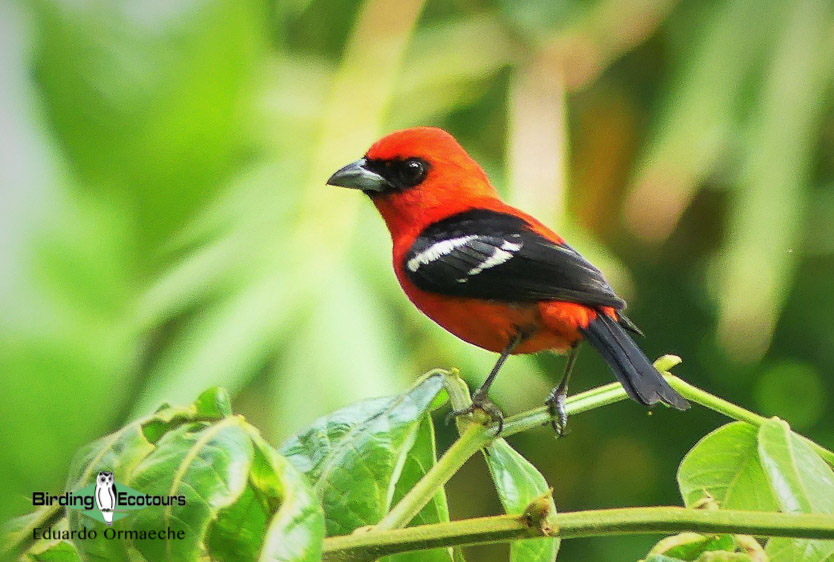
We also got nice views of Central America Spider Monkey and Collared Peccary. Then after a short introduction to the cultural highlights of the site, we left the Takalik Abaj and headed towards Finca El Patrocinio. Finca El Patrocinio is a shade-grown coffee hacienda that provides comfortable accommodation for those who desire to enjoy some nature. We arrived late in the day without much time for birding but with the hopes of some great birding the following morning.
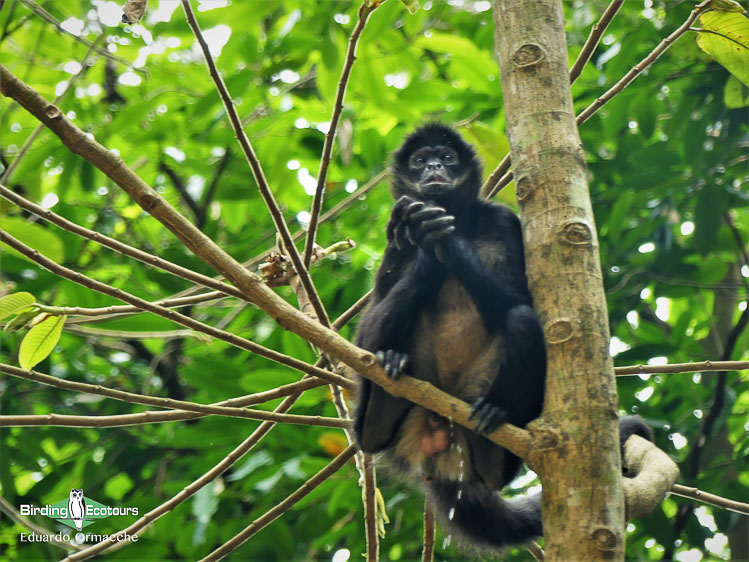
The next morning at Finca El Patrocinio started with a great pre-breakfast birding session from the beautiful dining room terrace from which we were able to hear the first dawn calls and enjoy the lovely views. After some coffee and tea, we were ready to enjoy our first White-bellied Chachalaca, Altamira and Baltimore Orioles, Yellow-throated Euphonia, and Cinnamon-bellied and Black-headed Saltators, many of which provided great views on the feeders. We then had a flock which included the likes of Tennessee Warbler, Rose-breasted Grosbeak, and White-winged, Summer, Yellow-winged and Blue-grey Tanagers. We heard Highland Guan but it was unfortunately only a distant call. Near the dining room, we managed to get Ruby-throated and Cinnamon Hummingbirds on the flowering bushes. We got scope views of Red-billed Pigeon and Ferruginous Pygmy Owl but probably the best bird of the day was Pacific Parakeet which we had great views of. Other interesting species included good scope views of White-fronted and Yellow-naped Amazons. We had a number of common species around our accommodation such as Clay-colored Thrush, House Wren, and Black and Turkey Vultures. We heard a Long-tailed Manakin but unfortunately it would remain unseen (for now).
A couple of hours later, huge rain clouds rolled in, and the heavens opened up, which kept us indoors, without any further birding for the rest of the afternoon. With the promise of a night walk, some participants were keen to rest. I decided to come early to the dining room to see what new species could be seen from the veranda when suddenly we felt the whole structure shaking, it was an earth tremor, the consequence of a small eruption of the Volcano of Fire, the very same volcano which was visited a few days ago. The rain stopped late and even though it spoiled our afternoon birding, it did allow us to go for a nocturnal walk. We did well to find a Nine-banded Armadillo and Tapeti (Brazilian Rabbit), and then we went for some herping as we heard that the place harbors a special species of treefrog, Morelet’s Treefrog. The local guide knew where to look for this and it didn’t take too long to see our first Morelet’s Treefrog, a species that occurs only in northern Central America and Mexico, with populations declining in some countries. At the same time, we managed to spot a Blunt-headed Tree Snake, a well-known frog predator, which was probably out hunting for frogs. We enjoyed a humorous moment when someone shouted “Snake”, which was misunderstood as a command to catch the snake and so we came up with the expression “No me Gusta” which would be a running joke for the remainder of the trip. We also found a few Cane Toads and a nice Southern Banana Salamander. Sadly, there were no night birds calling, so we all returned to the lodge to go to bed or enjoy a beer.
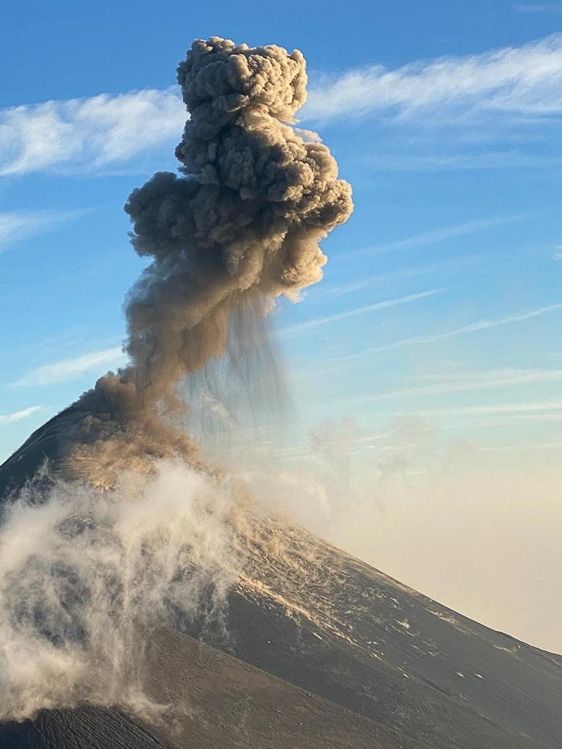
The next day we left the lodge after breakfast and drove to one of Guatemala’s classic tourist destinations, Fuentes Georginas. These hot springs, located in the lush mountains of the Quetzaltenango Department at an elevation of 8,200 feet (2,500 meters) above sea level, are a mandatory stop to get one of the most-prized birds of Guatemala, the stunning Pink-headed Warbler. This beauty is only found in the highlands of central Guatemala and east of Chiapas in Mexico.
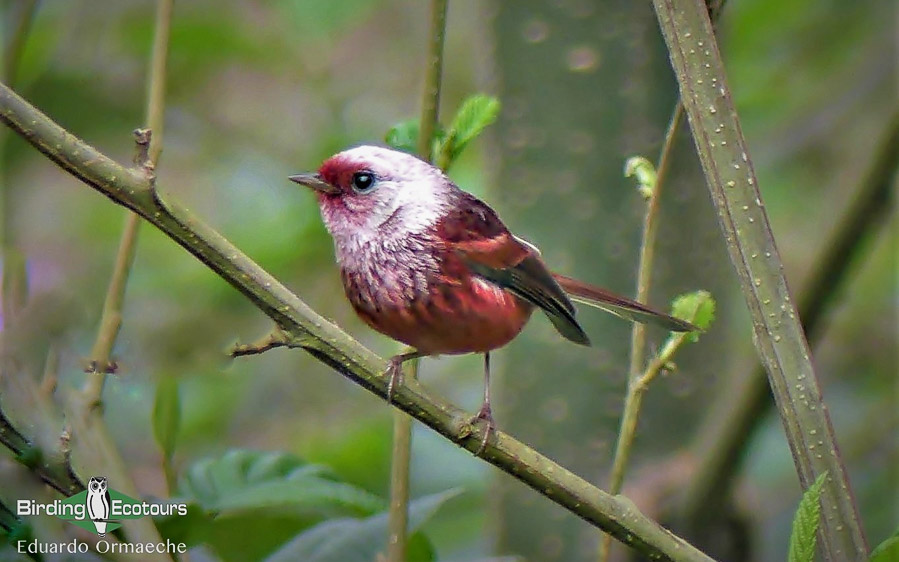
A couple of participants could not resist trying the warm waters of the hot springs which provided a nice relaxing moment. Back to the action, where it didn’t take long until we got a pair of stunning Pink-headed Warblers, literally in front of us at eye level. The area was soon covered by a thick fog however it did not affect the birding and immediately after seeing the Pink-headed Warbler, we saw the handsome Crescent-chested Warbler. Then we had fabulous views of Brown-backed Solitaire, followed by the stunning Unicolored Jay and Emerald Toucanet. In addition, we managed to see Black-and-white Warbler, Rufous-browed Wren, Rufous-collared Sparrow, Black-capped Swallow, Vaux’s Swift, and again we heard Highland Guan but again it was too far to be tracked down. We left the site and then headed back to the lowlands and had lunch in a nice restaurant where we had one of the tastiest meals of the trip and managed to see a couple of Brown Basilisk lizards in the garden. Then we started our drive to our next destination, the famous Tarrales Nature Reserve.
We arrived at Tarrales Nature Reserve a bit tired after a long day, but we managed to add a few bird species around the cabins including Orange-chinned Parakeet, Cinnamon Hummingbird, Ruby-throated Hummingbird, White-bellied Chachalaca, Yellow-throated Euphonia, Social Flycatcher, Great Kiskadee and other common species.
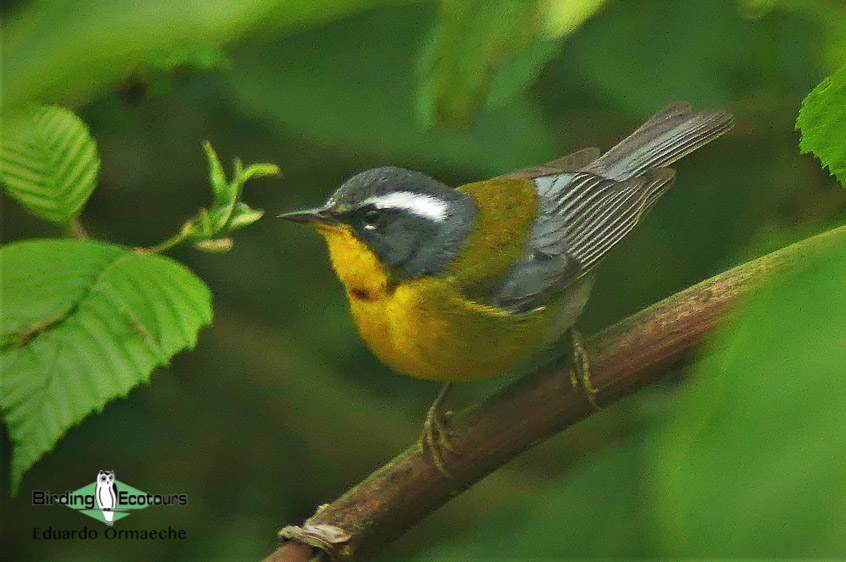
After dinner, we did a night walk but sadly, we could not get any owls despite hearing Black-and-white Owl in the vicinity. We did however find a Wood Thrush roosting at night, but the best surprise was the incredible and hard-to-see Northern Potoo. We found an individual at night at its roost, allowing the participants to get familiar with this amazing neotropical family.
The next morning, we went to visit a lagoon not far from the lodge where we spent some time before breakfast. Here we got great views of Sungrebe, Least Grebe, Spot-breasted and Orchard Orioles, Green Heron, Collared Aracari, Masked Tityra, Lesson’s Motmot, Rose-breasted Grosbeak and White-bellied Chachalaca. We returned to the lodge to get breakfast and after an amazing Guatemalan coffee, we started exploring the trails. The first target was found rather quickly, Northern Potoo which was still on its same perch as the night before and we could enjoy this incredible species in good light. The following birds were more difficult but we managed to find and get great views of Long-tailed Manakin, which proved somewhat difficult this year however we managed views of at least two males under the canopy at Tarrales. Tody Motmot proved particularly elusive, allowing us only to get brief views of it. Then we managed to get good views of Lineated Woodpecker, Turquoise-browed Motmot, Collared Aracari, Common Tody-Flycatcher, Boat-billed Flycatcher, White-throated Thrush, Rufous-and-white Wren, Gartered Trogon, and a dark morph Short-tailed Hawk.
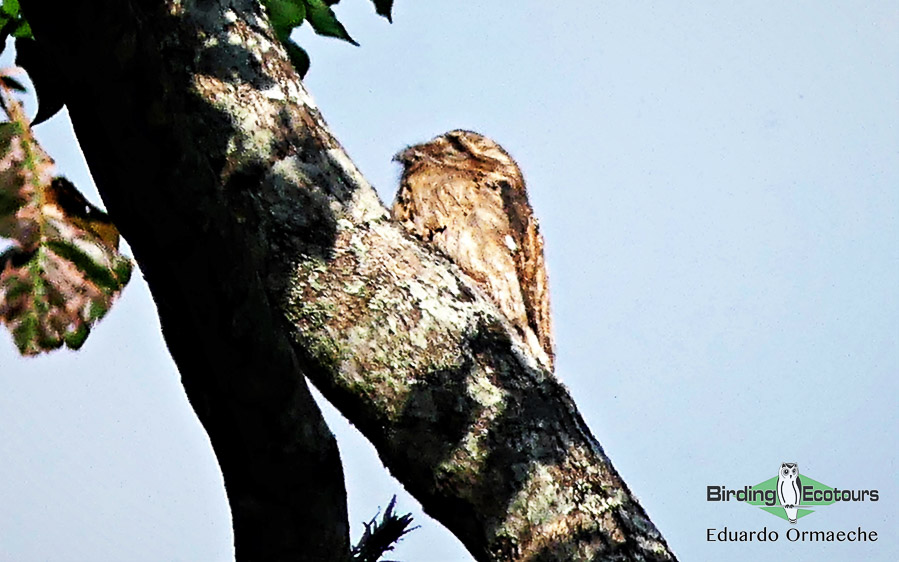
The group decided to have the afternoon off to bird on their own around the cabins and enjoy some drinks. On this trip we did not have time for the hike up the Atitlan Volcano, to look for the mythical Horned Guan but we knew that our next port of call was a good place to target some of the specials which occur at those higher elevations.
The next day we left at 04:30 to drive to Rey Tepepul Mirador on the shores of the Atitlan Lake. From here we partook in a moderate-to-demanding hike in the lush montane forest looking for Resplendent Quetzal. In our company, we now had a local guide, who knew where the quetzals had been seen recently. As we started our hike, we soon heard the calls of Brown-backed Solitaire, Highland Guan and Singing Quail and were rewarded with nice views of species such as Mountain Trogon, Emerald Toucanet, Dusky-capped Flycatcher, Tropical Pewee, Yellow-bellied Flycatcher, Bushy-crested Jay, White-eared Hummingbird, and Rufous-browed Wren. After searching for a while, there was still no sign of the quetzals and after trying a different trail, we finally managed to find a female that was nice to see. Thankfully, not much later we saw two male Resplendent Quetzals flying and displaying right above us. Then they moved to the top of the trees where we got some distant views and saw them flying away. It was a great experience, although probably not the sighting that a photographer would dream of, but we did get to see the magnificent silhouettes of the males flying and displaying above of us which was something I have not experienced before.
We continued our search until we got another target, the striking Blue-crowned Chlorophonia and we managed splendid views of the male of this most-wanted species. Then we came across a flock which included Black-and-white, Townsend’s, Wilson’s, Hermit, and Black-throated Green Warblers, and Slate-throated Whitestart. Finally, we got our last target, the localized Azure-rumped Tanager, sometimes known as Cabanis’s Tanager by other authorities, which is found only in Mexico and Guatemala.
We left the forest and walked along the road to a good stakeout for Blue-throated Motmot which showed very well for us all. We also got brief views of Blue-and-white Mockingbird which quickly disappeared into the thick vegetation. We left the area and caught our boat to cross the Atitlan Lake where we made a brief visit to an indigenous Mayan community and watched a weaving demonstration before it was time for our lunch and the transfer to Guatemala City.
We arrived in Guatemala City without problems and met Monica, a new tour participant for the second leg of the trip. We enjoyed a delicious Japanese supper at the hotel before we went to bed early to be ready for a 4 am start for our transfer to the airport and flight to Flores in Petén.
The next morning, we had some last-minute panic getting to the airport but soon made a plan and were happily on our way to the airport. We arrived on time to catch our flight to Flores, the capital of the Petén Department, in northern Guatemala. After a short and easy flight to Flores, we met our ground crew of Romulo and Giovani who took us for an excellent Guatemalan breakfast.
With caffeine in our system, we were ready to hit the road for a new adventure as we explored the Mayan rainforest of the Laguna El Tigre National Park. We took two 4×4 vehicles for a drive to the San Pedro River which originates in the Petén Department and flows into the Gulf of Mexico, 115 miles (186 kilometers) later. Along the drive, we stopped at some productive wetlands near the Petén Itza Lake on the San Benito Bridge. Here we managed to see some nice species such as Black-bellied Whistling Duck, Yellow-crowned Night, Green, Tricolored and Great Blue Herons, Purple Gallinule, Green, Ringed and Belted Kingfishers, Northern Jacana, a juvenile Snail Kite, Royal Tern, Spotted Sandpiper, and Wood Stork. We also got views of Vermilion and Fork-tailed Flycatchers, Morelet’s Seedeater, Blue and Ruddy Ground Dove, Mangrove Swallow, and Red-winged Blackbird.
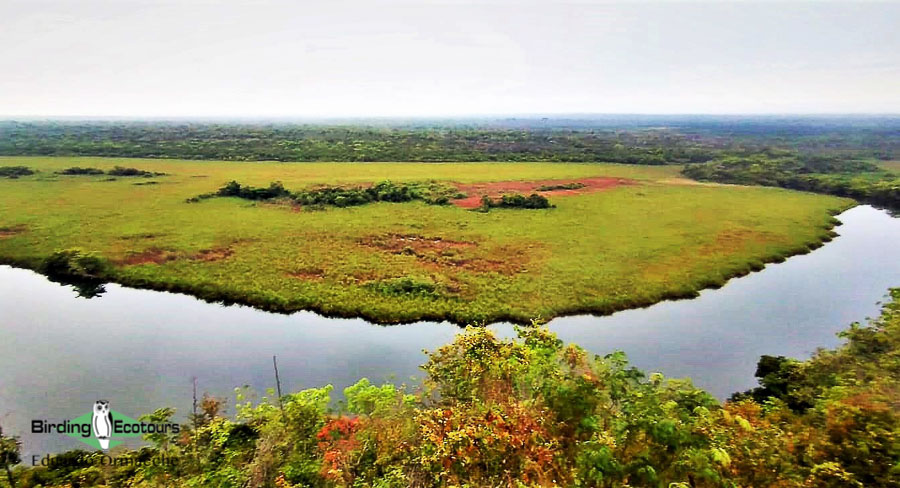
We arrived on the shores of the San Pedro River where we got our motorized boat to travel to Las Guacamayos Biological Station, our new port of call for the next couple of days. The boat trip felt so good as not only was this our first boat trip of the trip but also because we felt like we were back in nature, as we explored the national park, with nobody else around. We felt fortunate to have the station to ourselves and immediately checked into our beautiful rooms with great vistas of the river. At the feeders, we started adding more bird species including some hummingbirds such as Wedge-tailed Sabrewing, Green-breasted Mango, Rufous-tailed Hummingbird, and White-bellied Emerald. We also got our first Plain Chachalaca and Brown Jay, as well as a Lineated Woodpecker around the cabins.
We spent the afternoon on a nice boat trip looking for Agami Heron, one of the most-wanted species in the neotropics. The boat ride was fantastic and we could enjoy several species of birds such as Anhinga, Sungrebe, Rufescent Tiger, Great Blue, Boat-billed and Green Herons, Green, Amazon, Ringed and Belted Kingfishers, Pale-vented Pigeon, Blue Ground Dove, Red-lored Amazon, Black-bellied Whistling and Muscovy Ducks and lots of Mangrove Swallows. Unfortunately, we could not find the Agami Heron, but the boat ride was great and we then returned to the lodge to chill out and rest after a long day out. During our time at Las Guacamayos Biological Station, we were lucky to see several Morelet’s Crocodiles in the quiet waters of the San Pedro River. There was even one particular crocodile next to the lodge that the staff had nicknamed ‘Bobby’. This species of crocodilian only inhabits the Gulf of Mexico, northeast Guatemala and adjacent Belize, and it was a nice addition to the wildlife list.
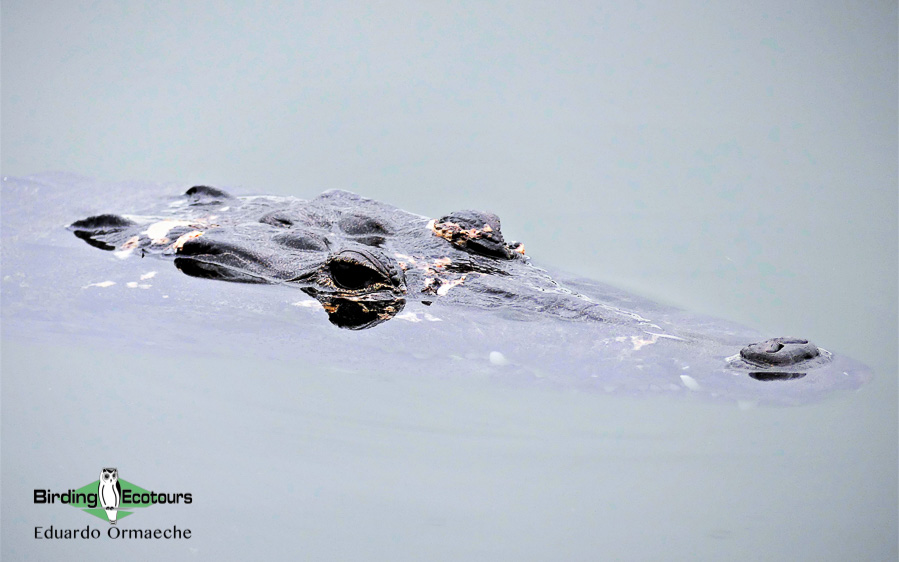
The next morning after an early breakfast, we left the station for a short boat ride to the entrance of the Waka Peru Trail. This is perhaps one of the best areas to bird around the station with the trail being a roughly four-mile (six-kilometer) hike to a Mayan archaeological site called Waka Peru, that dates back to around 300 BC. We did not walk all the way to the site as it takes up too much time and the trail is quite birdy right from the start. Here, we probably had one of the most rewarding birding sessions of the whole trip. In fact, the good birding started the moment we left the lodge while on a boat trip, as we decided to look for the secretive Ruddy Crake. We stopped the boat and had an incredible treat with not one but two birds right out in the open and even preening in front of us. We were just speechless and ecstatic.
As soon as we arrived at the Waka Peru Trail, we had good luck finding species such as the classic Velasquez’s Woodpecker, Keel-billed Toucan, Black-headed Trogon, Crested Guan, White-crowned Parrot, Pale-billed Woodpecker, Barred Antshrike, and Olivaceous, Ruddy, and Ivory-billed Woodcreepers. We had the chance to get better views of Tody Motmot, which certainly topped our sighting at Tarrales. We also managed to find another Northern Potoo at its daytime roost – one can never get tired of seeing this species. In addition, we found an incredible King Vulture perched in the top of a tree which provided fantastic views for us. We then had good looks at Rufous-tailed Jacamar, White-whiskered Puffbird, White-collared Manakin, Stub-tailed Spadebill, Northern Bentbill, Mangrove and White-eyed Vireos, Least Flycatcher, and Spot-breasted, and White-bellied Wrens. We heard the call of Thicket Tinamou and had views of Grey Catbird, Wood Thrush, Worm-eating Warbler, American Redstart, Summer and Grey-headed Tanagers, Red-crowned Ant Tanager, Chestnut-colored Woodpecker and Scarlet Macaw, whose population is declining in Guatemala, making Laguna del Tigre National Park one of their last-remaining refuges in the country.
After a lovely morning, we returned to the lodge to get a tasty lunch and a short break before heading back out onto the river to continue with our boat adventures. This time we focused on a small tributary called Sacluc River where we managed to find the diminutive American Pygmy Kingfisher which everyone managed to see well, giving us all five possible kingfisher species on this trip. We also found Montezuma Oropendola, Bat Falcon, Scarlet Macaw, Yellow-tailed Oriole, Prothonotary Warbler, Northern Waterthrush, Masked Tityra, Little Blue Heron, Keel-billed Toucan, Russet-naped Wood Rail, Squirrel Cuckoo, and right at the last minute, a couple of localized Yucatan Woodpeckers, a big target for the area. Our plans for a night-time boat excursion were spoiled by the rainy conditions, so we returned to the lodge for a tasty supper at the station and to get some rest.
The next morning, we climbed the station tower for a final birding session before being transferred to Flores. From the tower we got great views of birds such as White-necked Puffbird, Scaled Pigeon, Golden-olive Woodpecker, Trilling Gnatwren, and others such as Keel-billed Toucan, Pale-vented Pigeon, Plain Chachalaca, Masked Tityra, Red-lored Amazon, Blue-grey Gnatcatcher, and Brown Jay. The grounds around the station provided good views of Green-backed Sparrow and Blue Bunting. The vista from the tower were very nice and allowed us to get much better views of some of the canopy species. Sadly, we had a long journey ahead of us, so we said goodbye to the wonderful staff at Las Guacamayas and traveled along the San Pedro River to the 4×4 vehicles, to start our long drive. Along the drive, we managed to spot some new birds such as Eastern Meadowlark, Bronzed Cowbird, Blue-winged Teal, and Yellow-faced Grassquit. We also managed better views of Wood Storks and heard a Sora, but it remained in the thick vegetation, out of sight.
Once in Flores, we took the opportunity to check the shores of the Petén Itza Lake where we added some birds to our list such as Laughing Gull, Black-necked Stilt, and Eurasian Collared Dove (an introduced species to Central America) as well as more Neotropic Cormorants, Royal Terns, and Spotted Sandpipers. Our lunch was in a delightful spot called Posada Don Rodrigo, where we met Miguel who was our cultural guide for the Tikal visit. Some of the regular species showed up at the restaurant feeders such as Yellow-winged and Blue-grey Tanagers. A Yucatan Squirrel was a new mammal for the trip but was not seen by all of the group. A couple of the participants managed to get views of a Limpkin as it flew along the Peten Itza River. The final part of the drive was the transfer to the Jungle Lodge, inside the world-famous Tikal National Park. While in the park, at the entrance to the hotel, we scored with one of the big trip targets, the fabulous Ocellated Turkey, which showed magnificently well, we also saw a Grey Fox on the drive. We said goodbye to Romulo and Giovani and we checked in to the lodge. We planned to visit Tikal on that very same day to see the sunset from the top of Temple IV, one of the best places in the neotropics to see the scarce Orange-breasted Falcon.
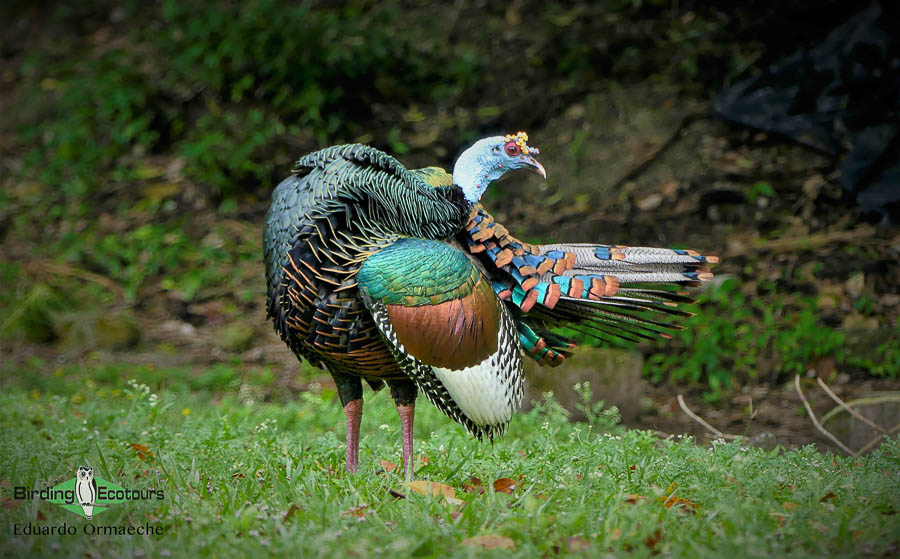
Tikal is one of the largest archaeological sites and urban centers of the ancient Mayan civilization which was declared a UNESCO World Heritage Site in 1979. The beautiful architecture, which dates back to 400 BC, is a collection of impressive Mayan stonework and is one of the best-preserved complexes of buildings, pyramids and temples around. It is surrounded by a lush and pristine tropical rainforest which just further adds to its appeal.

We left the lodge as planned, with Stripe-throated Hermit seen around the lodge feeding on the heliconia flowers. We saw conspicuous troops of White-nosed Coatis during our walk to the famous Temple IV. After a quick walk we managed to get to the top of the pyramids to get to a good place to set up the scope. We had two missions, one, enjoy the sunset and two, find the Orange-breasted Falcon, and we had good luck with both!
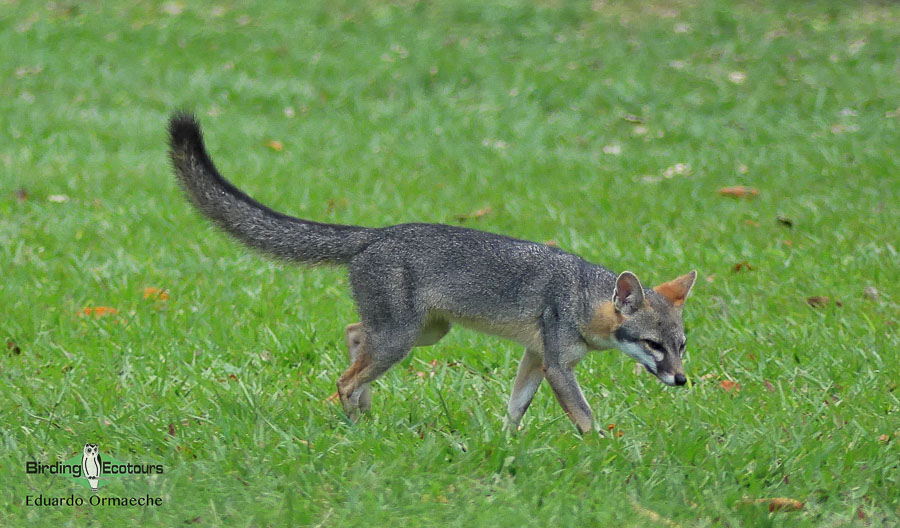
The view from the top of the temple was stunning as we waited for the sunset while enjoying views of dozens of Keel-billed Toucans, Red-lored Amazons, Montezuma Oropendolas, Northern Mealy Amazons, and even a couple of Brown-hooded Parrots. Other visitors were silent while waiting for the sunset as part of the religious ritual and only the sounds of Keel-billed Toucans, parrots, Great Tinamous, Plain Chachalacas, and Yucatan Black Howler Monkeys broke the silence!
While waiting, we got views of White-collared Swift, a single King Vulture and finally we managed our first Orange-breasted Falcon, perched on one of the pyramid’s walls, allowing us good scope views which were further improved later, when it came much closer in.
After getting a magnificent sunset and amazing views of this high-quality raptor we started descending from the pyramid and returned to the lodge. It was a long but wonderful day in Guatemala!
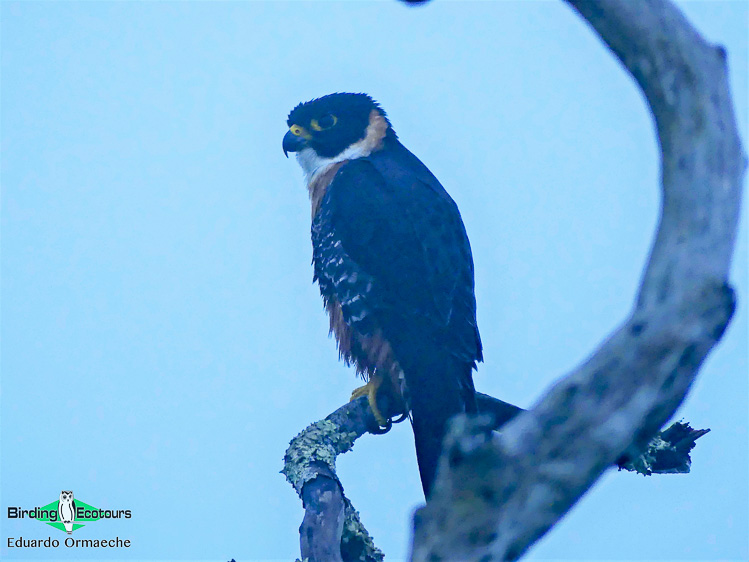
The next morning, we had a predawn start to walk back to the temple and catch the sunrise while hoping to see other species. Unfortunately, it was an overcast morning however we did get much better views of Orange-breasted Falcon. The call of a Pheasant Cuckoo was heard from the top of the temple, but it remained secretive. After a while, we decided to return to the lodge. We spent a few hours birding the parking area, getting species such as Mayan Antthrush, Yucatan Flycatcher, Grey-headed Dove, Plumbeous Kite, Slaty-tailed Trogon, Pale-billed and Lineated Woodpeckers, White-crowned Parrot, Olivaceous Woodcreeper, Red-capped Manakin, Yellow-bellied Flycatcher, Bright-rumped Attila, Orchard Oriole, Spot-breasted Wren, Wood Thrush, Kentucky Warbler, and White-eyed Vireo. We also heard the calls of Northern Schiffornis and Sulphur-rumped Myiobius. We then had another encounter with the magnificent Ocellated Turkey, providing pleasing views for everyone. By late morning, we decided to end the morning’s birding and returned to the lodge. Some of the participants went to visit the site’s museums and other interesting buildings in the afternoon, for a more comprehensive historical understanding, while the others took a rest to get ready for a drink or two in the afternoon, to celebrate a fabulous Guatemala trip.
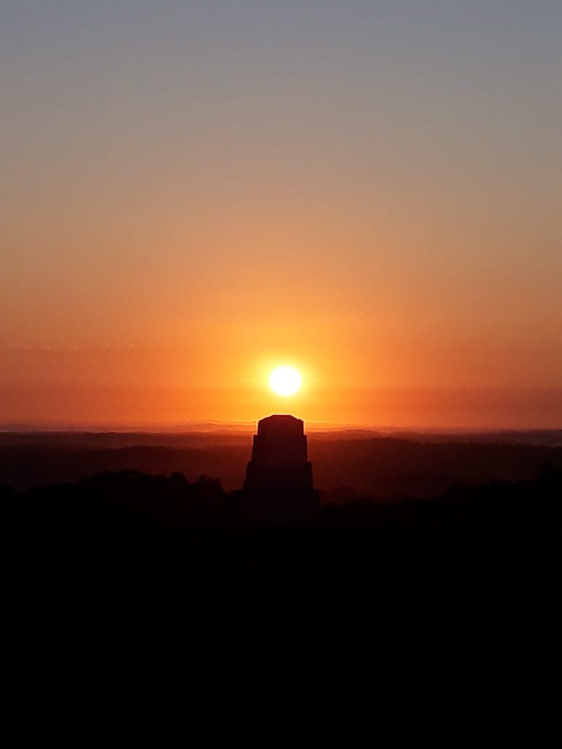
The next morning, we were transferred to the airport and took our flight back to Guatemala City where we said our farewells, with the promise of traveling together again in the near future.
Systematic Bird List – Following IOC (12.1)
Birds ‘heard only’ are marked with (H) after the common name, all other species were seen.
Tinamidae
Great Tinamou (H) Tinamus major This species was heard only at Tikal.
Thicket Tinamou (H) Crypturellus cinnamomeus This species was heard only at Las Guacamayas Station.
Anatidae
Black-bellied Whistling-Duck Dendrocygna autumnalis Nice views along the marshy areas on the way to Las Guacamayas Station.
Muscovy Duck Cairina moschata Seen during our boat rides along the San Pedro River.
Blue-winged Teal Spatula discors Seen on the marshy areas on the way back to Flores.
Cracidae
Plain Chachalaca Ortalis vetula Seen at Las Guacamayas Station and Tikal.
White-bellied Chachalaca Ortalis leucogastra Seen at Finca El Patrocinio and Finca Los Tarrales. Occurs from southern Mexico to Nicaragua.
Crested Guan Penelope purpurascens Seen at Tikal.
Highland Guan (H) Penelopina nigra Sadly heard only at several sites including Fuente Georginas and Rey Tepepul.
Odontophoridae
Singing Quail Dactylortyx thoracicus Seen by Eduardo at Finca El Pilar and heard in the forest at Rey Tepepul.
Phasianidae
Ocellated Turkey Meleagris ocellata Great encounters with this most-wanted species in the Tikal National Park.
Caprimulgidae
Lesser Nighthawk Chordeiles acutipennis Seen around dusk at Tarrales.
Parauque Nyctidromus albicollis Great views at El Patrocinio during the night walk and also seen later at Tarrales.
Nyctibiidae
Northern Potoo Nyctibius jamaicensis Great views at Tarrales at night and during the daytime, and later much better views of an individual roosting during the daytime at Guacamayas Station.
Apodidae
White-collared Swift Streptoprocne zonaris Seen in Tikal National Park.
Vaux’s Swift Chaetura vauxi Seen at Fuentes Georginas.
Trochilidae
Stripe-throated Hermit Phaethornis striigularis Seen feeding on Heliconia flowers around the Jungle Lodge reception in Tikal.
Green-breasted Mango Anthracothorax prevostii Seen at the Finca El Patrocinio feeders.
Rivoli’s Hummingbird Eugenes fulgens Seen by Eduardo at Finca El Pilar.
Green-throated Mountaingem Lampornis viridipallens Seen well during our hike in the mountains of Rey Tepepul. Occurs from southern Mexico to El Salvador.
Ruby-throated Hummingbird Archilochus colubris A female only at Finca El Patrocinio and Tarrales.
White-eared Hummingbird Basilinna leucotis Good views at Rey Tepepul. Seen also by Eduardo at Finca El Pilar.
Wedge-tailed Sabrewing Pampa pampa Great views at the Guacamayas Station feeders.
Rufous Sabrewing Pampa rufa Seen by Eduardo during his visit to Finca El Pilar.
Berylline Hummingbird Saucerottia beryllina Seen by Eduardo during his visit to Finca El Pilar.
Cinnamon Hummingbird Amazilia rutila Seen well at Finca El Patrocinio.
Rufous-tailed Hummingbird Amazilia tzacatl Seen well at the Las Guacamayas Station feeders.
White-bellied Emerald Chlorestes candida Seen at Las Guacamayas Station.
Cuculidae
Groove-billed Ani Crotophaga sulcirostris Seen along the drive from Flores to the San Pedro River dock.
Pheasant Cuckoo (H) Dromococcyx phasianellus Sadly heard only at dawn while waiting for the sunrise at the top of Temple IV in Tikal.
Squirrel Cuckoo Piaya cayana Seen at Tarrales and along the Waka Peru Trail in Las Guacamayas Station.
Columbidae
Rock Dove Columba livia Common in towns.
Band-tailed Pigeon Patagioenas fasciata Seen at Rey Tepepul.
Red-billed Pigeon Patagioenas flavirostris Seen at El Patrocinio.
Pale-vented Pigeon Patagioenas cayennensis Seen at Las Guacamayas Station.
Scaled Pigeon Patagioenas speciosa Seen from the observation tower at Las Guacamayas Station.
Eurasian Collared Dove Streptopelia decaocto Feral populations have colonized certain areas of northern Central America including Belize. Seen in the parking lot of Mayan Mall in Flores. Native from western Europe to India, China, and the Korean Peninsula.
Inca Dove Columbina inca Seen only by Sandra at Finca El Patrocinio.
Ruddy Ground Dove Columbina talpacoti Seen along the drive to the San Pedro River.
Blue Ground Dove Claravis pretiosa Seen at Las Guacamayas Station and along the 4×4 drive to San Pedro dock.
White-tipped Dove (H) Leptotila verreauxi This species was heard at Tarrales.
Grey-headed Dove Leptotila plumbeiceps Seen at Tikal.
White-winged Dove Zenaida asiatica Common in La Antigua city
Heliornithidae
Sungrebe Heliornis fulica A nice surprise in the lagoon at Los Tarrales. A most-wanted neotropical species! A member of the Heliornithidae family together with the African Finfoot and the Masked Finfoot, the only three members of this family. Unlike grebes they do not dive to obtain food, instead they pick prey off the water’s surface or forage on the shore.
Rallidae
Russet-naped Wood Rail Aramides albiventris Several sightings along the San Pedro River in Petén.
Sora (H) Porzana carolina This was heard only in a marshy area during our drive back to Flores.
Common Gallinule Gallinula galeata Seen in the wetlands next to the San Benito Bridge.
Purple Gallinule Porphyrio martinica Seen in the wetlands next to the San Benito Bridge.
American Coot Fulica americana Seen in the wetlands next to the San Benito Bridge.
Ruddy Crake Laterallus ruber An amazing, out-of-this-world sighting of two birds right in the open and crossing in front of us while calling and preening. These views were from the boat in the San Pedro River at Las Guacamayas. My best crake sighting ever!
Aramidae
Limpkin Aramus guarauna Brief views of one bird flying by from the restaurant Casa de Don David in the Remate Petén.
Podicipedidae
Least Grebe Tachybaptus dominicus Seen at Tarrales.
Recurvirostridae
Black-necked Stilt Himantopus mexicanus Seen in Flores at the shores of the Petén Itza Lake.
Jacanidae
Northern Jacana Jacana spinosa Many sightings along our drive to the San Pedro River.
Scolopacidae
Spotted Sandpiper Actitis macularius Seen in Flores at the shores of the Petén Itza Lake.
Laridae
Laughing Gull Leucophaeus atricilla Seen in Flores at the shores of the Petén Itza Lake.
Royal Tern Thalasseus maximus Seen flying above the San Benito Bridge and then at the shores of the Petén Itza Lake.
Ciconiidae
Wood Stork Mycteria americana Seen along our 4×4 drive to the San Pedro River.
Anhingidae
Anhinga Anhinga anhinga Seen along the San Pedro River.
Phalacrocoracidae
Neotropic Cormorant Nannopterum brasilianum Common along the San Pedro River.
Ardeidae
Bare-throated Tiger Heron Tigrisoma mexicanum Good views of a juvenile along the San Pedro River.
Boat-billed Heron Cochlearius cochlearius Seen on our nocturnal boat rides.
Yellow-crowned Night Heron Nyctanassa violacea Seen along the San Pedro River.
Green Heron Butorides virescens Seen at Tarrales and along the San Pedro River.
Western Cattle Egret Bubulcus ibis Seen along the drive to the San Pedro River.
Great Blue Heron Ardea herodias Several sightings along the San Pedro River.
Great Egret Ardea alba Seen in the wetlands on the way to the San Pedro River.
Tricolored Heron Egretta tricolor Seen by some on the wetlands next to the San Benito Bridge.
Little Blue Heron Egretta caerulea Several sightings in the lowlands of Petén.
Snowy Egret Egretta thula Few noted in the lowlands of Petén along our way to Las Guacamayas.
Cathartidae
King Vulture Sarcoramphus papa Amazing views of an individual perched near the Waka Peru Trail in Las Guacamayas Station. Not always easy to get perched views but always a pleasure to see!
Black Vulture Coragyps atratus Common throughout the trip.
Turkey Vulture Cathartes aura Common throughout the trip.
Accipitridae
White-tailed Kite Elanus leucurus Distant and hazy scope views of an individual at Las Guacamayas Station.
Grey-headed Kite Leptodon cayanensis One individual seen perched along the San Pedro River.
Swallow-tailed Kite Elanoides forficatus Seen by some at Tikal National Park. Not seen by the leader.
Double-toothed Kite Harpagus bidentatus Seen by Beth and Erika while visiting some of the buildings in the Tikal National Park guided by Miguel. Not seen by the leader.
Plumbeous Kite Ictinia plumbea A couple were seen at Tikal National Park.
Snail Kite Rostrhamus sociabilis A juvenile was seen in the wetlands next to the San Benito Bridge. Only the one sighting throughout the whole trip.
Common Black Hawk Buteogallus anthracinus Seen along our drive to the San Pedro River.
Roadside Hawk Rupornis magnirostris Few sightings on the trip.
Broad-winged Hawk Buteo platypterus Seen at Takalik Abaj and Finca El Patrocinio archaeological site.
Short-tailed Hawk Buteo brachyurus Seen at Rey Tepepul with a dark morph seen well at Tarrales.
Strigidae
Ferruginous Pygmy Owl Glaucidium brasilianum Seen at Takalik Abaj and later we managed scope views at Finca El Patrocinio.
Mottled Owl (H) Strix virgata Sadly only heard at Tarrales and at Las Guacamayas Station.
Black-and-white Owl (H) Strix nigrolineata Heard at Los Tarrales.
Trogonidae
Resplendent Quetzal Pharomachrus mocinno A female was seen perched shortly before we experienced two males flying above our heads which was surely one of the highlights of the trip. We saw this species at Rey Tepepul. The national bird and the name of the Guatemala currency, the quetzal (Q).
Collared Trogon Trogon collaris Seen by Eduardo at Finca El Pilar.
Mountain Trogon Trogon mexicanus Seen at Rey Tepepul. Found from Mexico to Honduras.
Gartered Trogon Trogon caligatus Seen at Tarrales.
Black-headed Trogon Trogon melanocephalus Seen along the Waka Peru Trail at Guacamayas Station.
Alcedinidae
Amazon Kingfisher Chloroceryle amazona Seen at San Benito Bridge.
American Pygmy Kingfisher Chloroceryle aenea Great views while birding from the boat at Las Guacamayas.
Green Kingfisher Chloroceryle americana Seen along the San Pedro River.
Ringed Kingfisher Megaceryle torquata Seen along the San Pedro River and at the San Benito Bridge.
Belted Kingfisher Megaceryle alcyon Seen at the San Benito Bridge.
Momotidae
Tody Motmot Hylomanes momotula This shy species didn’t prove very cooperative this time only allowing quick views at both Los Tarrales and Las Guacamayas.
Blue-throated Motmot Aspatha gularis Short but good views of this shy species near Lake Atitlan.
Lesson’s Motmot Momotus lessonii Seen in the hotel grounds of La Antigua and Finca El Patrocinio.
Turquoise-browed Motmot Eumomota superciliosa Great looks at Takalik Abaj and Tarrales. The national bird of Nicaragua.
Galbulida
Rufous-tailed Jacamar Galbula ruficauda Seen along the Waka Peru Trail in Las Guacamayas.
Bucconidae
White-necked Puffbird Notharchus hyperrhynchus Great views from the observation tower at Las Guacamayas.
White-whiskered Puffbird Malacoptila panamensis Great views along the Waka Peru Trail.
Ramphastidae
Emerald Toucanet Aulacorhynchus prasinus Great views at Rey Tepepul. Heard also at Fuentes Georginas.
Collared Aracari Pteroglossus torquatus Good views at Finca Patrocinio, Los Tarrales and Takalik Abaj.
Keel-billed Toucan Ramphastos sulfuratus Amazing views at Tikal. The national bird of Belize.
Picidae
Yucatan Woodpecker Melanerpes pygmaeus Great views at Las Guacamayas. This is an endemic of the Yucatan Peninsula and in Guatemala is only found in the northeast of the country.
Velasquez’s Woodpecker Melanerpes santacruzi The most commonly encounter woodpecker with views at Antigua, Finca Patrocinio, Tarrales and Takalik Abaj. This is a split from Golden-fronted Woodpecker but not accepted by all ornithological authorities. According to IOC Velasquez’s Woodpecker is found from eastern Mexico to Nicaragua and the islands off Honduras while Golden-fronted Woodpecker is found from southern USA to central Mexico.
Smoky-brown Woodpecker Leuconotopicus fumigatus Seen at Tarrales.
Golden-olive Woodpecker Colaptes rubiginosus Seen at Las Guacamayas from the observation tower.
Chestnut-colored Woodpecker Celeus castaneus Just a brief glimpse of this attractive woodpecker on the Waka Peru Trail in Las Guacamayas.
Lineated Woodpecker Dryocopus lineatus We saw our first at Takalik Abaj archeological site.
Pale-billed Woodpecker Campephilus guatemalensis Seen at Las Guacamayas and Tikal.
Falconidae
Crested Caracara Caracara plancus Several sightings.
Laughing Falcon Herpetotheres cachinnans Only one sighting of this handsome raptor on the trip.
Collared Forest Falcon (H) Micrastur semitorquatus This was heard at Tikal after dawn.
Bat Falcon Falco rufigularis Seen along the San Pedro River in Las Guacamayas.
Orange-breasted Falcon Falco deiroleucus Superb views on consecutive days from the top Temple IV in the Tikal forest. A most-wanted species! Its historical range went from southern Mexico to northern Argentina, although now it seems to have disappeared from all of Central America except Panama, Belize and Guatemala. Recent studies suggest that the Central American population in Belize and Guatemala is isolated from the one in Panama and the rest of South America.
Psittacidae
Orange-chinned Parakeet Brotogeris jugularis Good views of a flock flying above Tarrales.
Brown-hooded Parrot (H) Pyrilia haematotis Silhouettes seen flying and calling by above Tikal at sunset.
White-crowned Parrot Pionus senilis Seen at Tikal.
White-fronted Amazon Amazona albifrons Great views at Finca El Patrocinio.
Red-lored Amazon Amazona autumnalis Great views at Tikal.
Yellow-naped Amazon Amazona auropalliata Seen at Finca El Patrocinio.
Northern Mealy Amazon Amazona guatemalae Several birds were seen flying above Tikal. According to IOC Northern Mealy Amazon occurs from southeast Mexico to western Panama and Southern Mealy Amazon Amazona farinosa from southern Panama to Bolivia.
Olive-throated Parakeet (H) Eupsittula nana This was only heard flying above the canopy forest of Las Guacamayas Biological Station.
Scarlet Macaw Ara macao Great views along the Waka Peru Trail in Las Guacamayas. Rare in Guatemala with probably 250 individuals remain in the wild.
Pacific Parakeet Psittacara strenuous Good views at Finca El Patrocinio. Found from Mexico to Nicaragua.
Furnariidae
Olivaceous Woodcreeper Sittasomus griseicapillus Seen at Las Guacamayas. Here of the race gracileus.
Ruddy Woodcreeper Dendrocincla homochroa Brief views along the Waka Peru Trail at Las Guacamayas Biological Station.
Ivory-billed Woodcreeper Xiphorhynchus flavigaster Seen at Takalik Abaj archaeological site.
Thamnophilidae
Barred Antshrike Thamnophilus doliatus Seen along the Waka Peru Trail.
Formicariidae
Mayan Antthrush Formicarius moniliger An amazing encounter with this ground skulker at Tikal. Formerly conspecific with Black-faced Antthrush Formicarius analis.
Tyrannidae
Northern Bentbill Oncostoma cinereigulare Great views at Tikal and Las Guacamayas.
Common Tody-Flycatcher Todirostrum cinereum Nice views at Las Guacamayas.
Yellow-olive Flatbill Tolmomyias sulphurescens Seen by some at Takalik Abaj.
Stub-tailed Spadebill Platyrinchus cancrominus Good views of this little bird along the Waka Peru Trail.
Tropical Pewee Contopus cinereus Several encounters with this species.
Yellow-bellied Flycatcher Empidonax flaviventris Seen at Rey Tepepul.
Vermilion Flycatcher Pyrocephalus obscurus Seen along the 4×4 drive to the San Pedro dock.
Social Flycatcher Myiozetetes similis Several sightings.
Great Kiskadee Pitangus sulphuratus Several sightings.
Sulphur-bellied Flycatcher Myiodynastes luteiventris A glimpse by the leader and some participants at Tarrales.
Boat-billed Flycatcher Megarynchus pitangua Seen at Tarrales.
Tropical Kingbird Tyrannus melancholicus Several sightings.
Fork-tailed Flycatcher Tyrannus savana Splendid views during the 4×4 drive to Puerto San Pedro.
Yucatan Flycatcher Myiarchus yucatanensis Seen at Tikal. Endemic to the Yucatan Peninsula.
Dusky-capped Flycatcher Myiarchus tuberculifer Seen at Rey Tepepul.
Bright-rumped Attila Attila spadiceus Widespread and common but more often heard than seen. We got a couple of good encounters at Las Guacamayas from the observation tower and later in the Tikal National Park.
Pipridae
Long-tailed Manakin Chiroxiphia linearis We struggled a bit to get good views of this manakin but eventually we got views of a couple of males in the subcanopy of Tarrales.
White-collared Manakin Manacus candei Seen along the Waka Peru Trail at Las Guacamayas.
Red-capped Manakin Ceratopipra mentalis Seen along the Waka Peru Trail at Las Guacamayas.
Tityridae
Sulphur-rumped Myiobius Myiobius sulphureipygius This species was seen by the leader outside the cabins of the Jungle Lodge at Tikal National Park.
Masked Tityra Tityra semifasciata Several seen at Tikal, Takalik Abaj, and Las Guacamayas.
Northern Schiffornis (H) Schiffornis veraepacis This species was heard at Tikal National Park.
Rose-throated Becard Pachyramphus aglaiae Good views at Takalik Abaj.
Vireonidae
Chestnut-sided Shrike-Vireo (H) Vireolanius melitophrys This species was heard by the leader during his Finca El Pilar visit.
Warbling Vireo Vireo gilvus Seen at Takalik Abaj.
Mangrove Vireo Vireo pallens Good views of this bird at Las Guacamayas.
White-eyed Vireo Vireo griseus Seen at Takalik Abaj, Las Guacamayas and Tikal National Park.
Corvidae
Bushy-crested Jay Cyanocorax melanocyaneus Seen in the grounds of our hotel in La Antigua and Fuentes Georginas.
Brown Jay Psilorhinus morio Seen at Finca El Patrocinio and Takalik Abaj.
White-throated Magpie-Jay Calocitta formosa Nice views of this beautiful bird at Takalik Abaj and Finca El Patrocinio.
Unicolored Jay Aphelocoma unicolor Great views at Fuente Georginas. Found from Mexico to Honduras.
Ptiliogonatidae
Grey Silky-flycatcher Ptiliogonys cinereus The group had good views of this species during the hike to the Acanetango Volcano. A near-endemic found in Mexico and Guatemala.
Hirundinidae
Mangrove Swallow Tachycineta albilinea Seen along the San Pedro River.
Black-capped Swallow Atticora pileata Seen at Finca El Pilar, Fuentes Georginas and Rey Tepepul. Found from Mexico to El Salvador.
Northern Rough-winged Swallow Stelgidopteryx serripennis Several sightings such as at La Antigua.
Grey-breasted Martin Progne chalybea Seen in the Petén lowlands.
Barn Swallow Hirundo rustica A couple were spotted by Sandra during the trip.
Troglodytidae
Rufous-backed Wren Campylorhynchus capistratus Several sightings including brilliant views at Finca El Pilar. Treated as Rufous-naped Wren by other authorities.
Spot-breasted Wren Pheugopedius maculipectus Good views along the San Pedro River near Las Guacamayas. Found from Mexico to Costa Rica.
Rufous-and-white Wren Thryophilus rufalbus Brief views at Takalik Abaj.
House Wren Troglodytes aedon Several sightings such as at Finca El Patrocinio.
Rufous-browed Wren Troglodytes rufociliatus Seen at Fuentes Georginas and at a couple other places.
White-bellied Wren Uropsila leucogastra Seen along the Waka Peru Trail at las Guacamayas. Found from southern Mexico to northern Guatemala, Belize and northern Honduras.
Polioptilidae
Trilling Gnatwren Ramphocaenus melanurus Seen at Las Guacamayas Station from the observation tower. Formerly Long-billed Gnatwren Ramphocaenus melanurus which has been split into Trilling Gnatwren Ramphocaenus melanurus from Mexico through to Amazonia in South America and Chattering Gnatwren Ramphocaenus sticturus ranging from southwest Brazil to eastern Peru and northern Bolivia.
Blue-grey Gnatcatcher Polioptila caerulea Seen at Las Guacamayas Biological Station.
Mimidae
Grey Catbird Dumetella carolinensis Several sightings at Las Guacamayas.
Tropical Mockingbird Mimus gilvus Seen during the 4×4 drive to the San Pedro River dock.
Blue-and-white Mockingbird Melanotis hypoleucus Brief views at the Blue-throated Motmot spot near Rey Tepepul. Found from Mexico to El Salvador.
Turdidae
Brown-backed Solitaire Myadestes occidentalis Great views at Fuentes Georginas. It was heard at Finca El Pilar and Rey Tepepul.
Wood Thrush Hylocichla mustelina One individual was seen roosting at night during our night walk at Tarrales.
Swainson’s Thrush Catharus ustulatus Few seen in the Petén lowlands.
White-throated Thrush Turdus assimilis One seen at Tarrales.
Clay-colored Thrush Turdus grayi Several sightings. The national bird of Costa Rica.
Passeridae
House Sparrow Passer domesticus Continuously seen at gas stations, not matter where we went.
Fringillidae
Elegant Euphonia Chlorophonia elegantissima Splendid views of a male at Finca El Patrocinio.
Blue-crowned Chlorophonia Chlorophonia occipitalis Great views at Rey Tepepul. Found from Mexico to Nicaragua.
Yellow-throated Euphonia Euphonia hirundinacea The most commonly encountered euphonia. Seen at Finca El Patrocinio and Tarrales.
Olive-backed Euphonia Euphonia gouldi Seen by the leader around the rooms at Las Guacamayas.
Passerellidae
Green-backed Sparrow Arremonops chloronotus Seen around the rooms at Las Guacamayas.
Yellow-eyed Junco Junco phaeonotus Seen by the group during the hike up the Acatenango Volcano. Here of the race alticola an endemic of Chiapas in Mexico and western Guatemala. Some authorities suggest splitting it as Guatemala Junco.
White-eared Ground Sparrow Melozone leucotis This was seen by the leader during his visit to Finca El Pilar.
Icteridae
Eastern Meadowlark Sturnella magna Seen by Beth and Erika in Giovanni’s vehicle during the drive to Tikal.
Yellow-billed Cacique (H) Amblycercus holosericeus This was heard at Tarrales but was completely ignored as our attention was focused on seeing Long-tailed Manakin.
Montezuma Oropendola Psarocolius montezuma Several seen in Tikal and Las Guacamayas.
Altamira Oriole Icterus gularis Seen at Finca El Patrocinio.
Baltimore Oriole Icterus galbula The most commonly encountered oriole of the trip.
Yellow-tailed Oriole Icterus mesomelas Seen at Tarrales.
Spot-breasted Oriole Icterus pectoralis Seen at Tarrales while visiting the lagoon.
Black-cowled Oriole Icterus prosthemelas Seen by the leader near the rooms at Las Guacamayas.
Orchard Oriole Icterus spurius Seen at Finca El Patrocinio.
Red-winged Blackbird Agelaius phoeniceus Seen at the San Benito Bridge.
Bronzed Cowbird Molothrus aeneus Seen by Beth and Erika in Giovanni’s vehicle during the drive to Tikal.
Melodious Blackbird Dives dives Few seen during the trip.
Great-tailed Grackle Quiscalus mexicanus Common throughout.
Parulidae
Worm-eating Warbler Helmitheros vermivorum Seen at Las Guacamayas.
Louisiana Waterthrush Parkesia motacilla Seen at Las Guacamayas.
Northern Waterthrush Parkesia noveboracensis Seen at Tikal and Tarrales.
Black-and-white Warbler Mniotilta varia Several sightings.
Prothonotary Warbler Protonotaria citrea Nice views along the San Pedro River.
Crescent-chested Warbler Oreothlypis superciliosa Great views at Fuentes Georginas. Found from Mexico to Nicaragua.
Tennessee Warbler Leiothlypis peregrina Several sightings.
Kentucky Warbler Geothlypis formosa Seen at Tikal only.
Common Yellowthroat Geothlypis trichas Beautiful views at Las Guacamayas.
Hooded Warbler Setophaga citrina Seen at Tikal.
American Redstart Setophaga ruticilla Seen at Tarrales.
Magnolia Warbler Setophaga magnolia Few sightings throughout the trip.
American Yellow Warbler Setophaga aestiva Several sightings.
Townsend’s Warbler Setophaga townsendi A couple of sightings including at Rey Tepepul.
Golden-cheeked Warbler Setophaga chrysoparia Seen at Rey Tepepul.
Black-throated Green Warbler Setophaga virens Seen at Rey Tepepul and by the leader at Finca El Pilar.
Wilson’s Warbler Cardellina pusilla Several sightings.
Pink-headed Warbler Cardellina versicolor One of the highlights of the trip. Great views at Fuentes Georginas. A near-endemic of Mexico and Guatemala. It was also seen by the group during the hike up Acatenango Volcano.
Slate-throated Whitestart Myioborus miniatus Seen at Rey Tepepul.
Cardinalidae
Hepatic Tanager Piranga hepatica Seen by the leader at Finca El Pilar.
Summer Tanager Piranga rubra Several sightings.
Western Tanager Piranga ludoviciana Nice views at Takalik Abaj.
White-winged Tanager Piranga leucoptera Seen at Takalik Abaj.
Red-crowned Ant Tanager Habia rubica Seen along the Waka Peru Trail in Las Guacamayas.
Rose-breasted Grosbeak Pheucticus ludovicianus Several sightings including at El Patrocinio and Takalik Abaj.
Blue Bunting Cyanocompsa parellina Nice views at Las Guacamayas.
Painted Bunting Passerina ciris Great views at Takalik Abaj.
Thraupidae
Red-legged Honeycreeper Cyanerpes cyaneus Seen at El Patrocinio and Tarrales.
Cinnamon-bellied Saltator Saltator grandis Seen at Finca El Patrocinio. Formerly Greyish Saltator Saltator coerulescens which was split into three species: Cinnamon-bellied Saltator from Mexico to Costa Rica; Olivaceous Saltator Saltator olivascens from northern Colombia to Trinidad and Tobago and northern Brazil; and Blue-grey Saltator Saltator coerulescens from Amazonia to southern Peru and northern Argentina and Uruguay.
Black-headed Saltator Saltator atriceps Seen at Finca El Patrocinio.
Bananaquit Coereba flaveola Seen at Tarrales.
Yellow-faced Grassquit Tiaris olivaceus Seen by Sandra, Jennifer, and Eduardo in Romulo’s vehicle during the drive to Tikal.
Blue-black Grassquit Volatinia jacarina Seen around Puente San Benito.
Grey-headed Tanager Eucometis penicillata Good views in the subcanopy along the Waka Peru Trail.
Morelet’s Seedeater Sporophila morelleti Seen at Puente San Benito. Named after Pierre Marie Arthur Morelet, a 19th century French naturalist, artist and collector. He collected specimens in the Canary Islands, Guatemala and Mexico. There are other taxa named after him including Morelet’s Crocodile and Morelet’s Treefrog which we saw both of on this trip.
Azure-rumped Tanager Poecilostreptus cabanisi Great views at Rey Tepepul. A near-endemic found in southern Mexico and Guatemala. Referred to as Cabanis’s Tanager by other authorities.
Blue-grey Tanager Thraupis episcopus Nice views at Finca El Patrocinio.
Yellow-winged Tanager Thraupis abbas Nice views at Finca El Patrocinio.
Wildlife List
Geoffroy’s Spider Monkey Ateles geoffroyi Seen at Takalik Abaj, Las Guacamayas and Tikal.
Yucatan Black Howler Monkey (H) Alouatta pigra Heard at Tikal and Las Guacamayas.
White-nosed Coati Nasua narica Great views at Tikal.
Collared Peccary Dicotyles tajacu Seen at Takalik Abaj.
Mexican Grey Squirrel Sciurus aureogaster Seen at Rey Tepepul.
Variegated Squirrel Sciurus variegatoides Seen at Tarrales.
Deppe’s Squirrel Sciurus deppei Seen in La Antigua, Finca El Patrocinio and Rey Tepepul.
Yucatan Squirrel Sciurus yucatanensis Seen at the feeders of our restaurant at El Remate before arriving at Tikal.
Central American Agouti Dasyprocta punctata Seen at Tarrales.
Tapeti Sylvilagus brasiliensis Seen at Tarrales during our night walk. Sometimes call Brazilian Rabbit.
Proboscis Bat Rhynchonycteris naso Seen at Las Guacamayas while at a daytime roost.
Nine-banded Armadillo Dasypus novemcinctus Seen during our night walk at Finca El Patrocinio.
Grey Fox Urocyon cinereoargenteus Great views at Tikal.
White-tailed Deer Odocoileus virginianus Seen at Tarrales.
Common House Gecko Hemidactylus frenatus Few sightings on the trip.
Green Iguana Iguana iguana Seen at Las Guacamayas.
Brown Basilisk Basiliscus vittatus Seen in the restaurant garden during our lunch break before our transfer to Tarrales.
Rose-bellied Lizard Sceloporus variabilis Seen at Las Guacamayas Station.
Morelet’s Crocodile Crocodylus moreletii Seen along the San Pedro River including our friend nicknamed ‘Bob’.
Blunt-headed Tree Snake Imantodes cenchoa Seen at Finca El Patrocinio during our night walk.
Central American Whiptail Holcosus festivus Seen at Finca El Patrocinio.
Morelet’s Treefrog Agalychnis moreletii Seen at night at Finca El Patrocinio.
Cane Toad Rhinella marina Seen at night at Finca El Patrocinio.
Southern Banana Salamander Bolitoglossa occidentalis Seen at night at Finca El Patrocinio.
This is a sample trip report. Please email us ([email protected]) for more trip reports from this destination.
